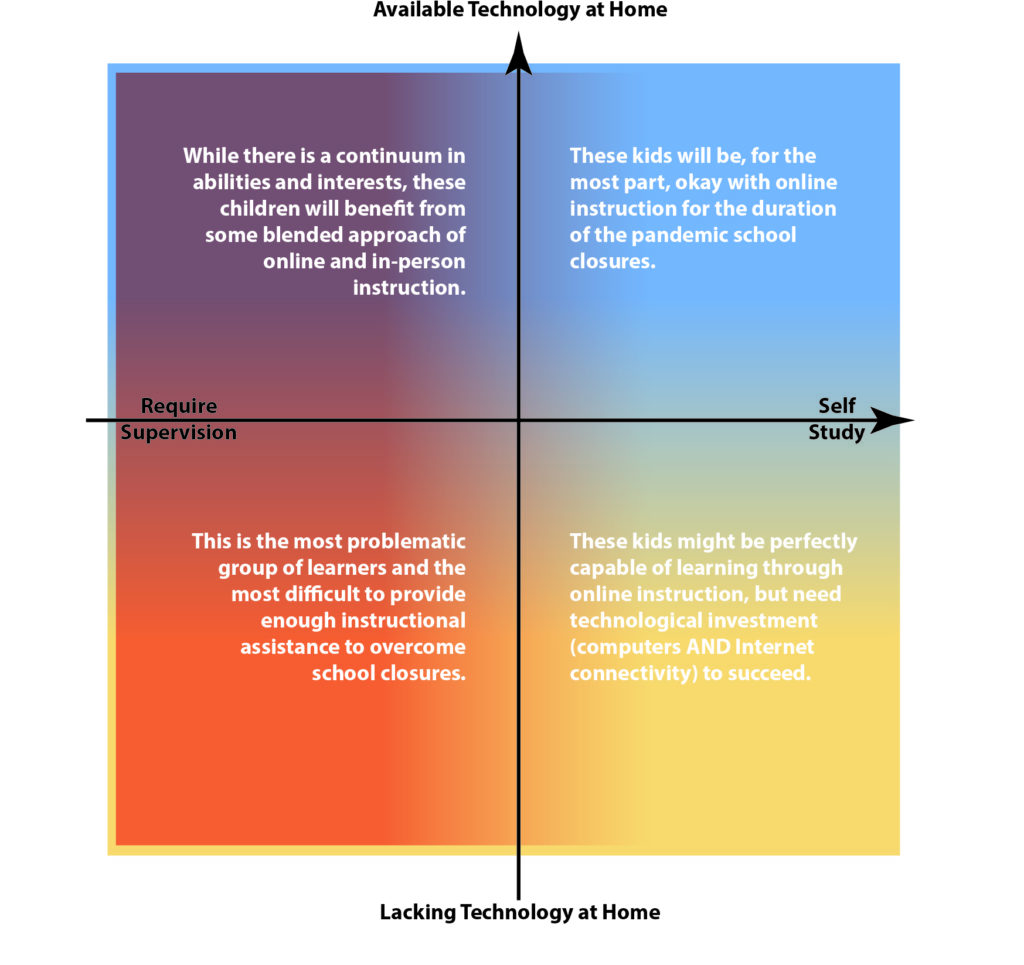Digital and Cognitive Divide Versus Schooling During the Pandemic

We can’t treat all kids the same, because they are not. Each kid is an individual with a set of individual needs, talents, interests, and physical limitations, family circumstances, etc. Obviously, during a worldwide pandemic, we can’t design a general system that would address all the differences. One system for all would create winners and losers. But we can create broad generalizations and then ask teachers and parents to finetune the instruction to meet a particular child’s needs.
Broadly then, we can divide kids by their access to technology. It is silly to assume that every kid has a computer that they could use all day without sharing with other family members. It is also wrong to assume that all kids have equal access to the Internet. There have been many articles on how some kids have to do their schoolwork sitting in the parking lot of some fast food joint — they simply don’t have access at home.
Obviously for kids without access to technology online instruction is simply impossible. School districts have to provide computing devices and cities need to think of access to the Internet the same way they think about power, water, sewer, garbage, and gas — essential services for its citizens. But even if schools manage to give each kid who lacks a computing device some basic tablet to do their work, those kids will still be at a disadvantage when compared to kids with the latest and greatest technology available at home. So when we provide public school access as online-only instruction, we knowingly administer unequal education in our communities.
Access to computing devices and the Internet is not the only divide that’s easy to understand among the students. The cognitive divide is just as much of an obstacle as the lack of technology. Let’s start with the easy one — age. While we might pretend otherwise, kids are not born technology users. Knowing how to use a computer, how to type, how to perform a search, how to save documents to a shared folder, how to use Zoom…how to read and how to write are not skills we can assume of Kindergarteners or First-graders…or Second-graders…or Third-graders…or Fourth-graders… How we approach teaching preschool kids is obviously different from how we structure instruction in upper elementary school. Younger kids require supervision when they do work on computers. They require technical support. They require attention support. In addition to instructional support.
If you look at the chart above, it’s obvious that no matter how good the access to technology and the Internet young kids have, they will still not succeed in the online-only world of instruction. They need in-person learning. It is not all or nothing, of course, the older the kids get, the more autonomy they gain over their own learning. We can’t say that ALL fourth-graders will do all right in online instruction, but some will. Maturity does happen, but it doesn’t strike at some pre-defined age. It’s a range.

Age is not the only factor. ADHD, dyslexia, hearing and visual impairments, and other physical and cognitive handicaps limit what those kids can easily achieve with online-only instruction without supervision. Just throwing technology at these kids won’t solve the problem (although it would help!). If we don’t “think different” about how to support these children, they will be left behind their contemporaries that don’t have to overcome those barriers to learning.
So to quickly summarize, kids who fall in the bottom left quadrant — low access to technology and low ability to manage their own education — really would benefit from in-person instruction.
Kids who fall into the upper left quadrant — those who have access to technology but still can’t manage their own education for a variety of reasons including being too young — need some sort of hybrid model. Perhaps they can do something on a computer but the majority of instruction will need to be supervised with in-person teachers.
Kids who belong in the top right quadrant — those who are mature-enough, able-enough, motivated-enough, and have access to technology — would be just fine with online-only education for a long while (but not indefinitely).
Kids in the bottom right quadrant — those who can work independently but lack the resources to do so — just need to be provided with enough computing technology to succeed. And just like the kids above, they would be fine for along time.
But thinking about these four groups of children, we can make better choices as to how to allocate our resources. If you have high school-aged kids who are motivated and self-starters, set them up with online learning for the duration of the pandemic. In fact, I’d recommend community college courses for those who ready to take them. Might as well earn college credit.
If you have kids who lack technology, you need to demand those resources from your school district. But given the limited funds, forming educational family co-ops would help stretch those resources across multiple kids and multiple families.
For the kids on the left side of the cognitive divide, including those for whom English is a second language, educational co-ops are really the way to go. Whether you hire private teachers or split the responsibility of teaching kids among several parents, it will guarantee that those children will learn and won’t bring the pandemic home with them.
